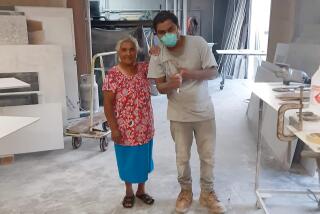TMJ Victims Blame Teflon Jaw Implants for Much Pain and Suffering : Medicine: Device, now off the market, was intended to cure an excruciating ailment. Inventor moved to Switzerland to escape lawsuits; firm is bankrupt.
- Share via
TUCSON — Betty Jean Meyer used to be a top real estate agent who looked forward to having children. But now, she would settle for a moment without pain.
At the mercy of a jaw disorder that has worsened despite four operations, she spends many days in a quiet, darkened room. She takes methadone for pain relief and says only the support of her husband and love of her adopted daughter have saved her from suicide.
“The last five years have just been a nightmare,” said Meyer, a 42-year-old Tucson resident.
Meyer is among thousands who received a promising medical technology that failed, a Teflon-coated surgical implant meant to cure an excruciating ailment of the jaw joint called temporomandibular joint syndrome or disorder.
Problems with the implants have left a trail of torment, accusations, litigation, tattered reputations, even suicides.
The company that made the implants, Vitek Inc. of Houston, went out of business under a deluge of lawsuits.
The man who invented the implants--and the material from which they’re made--has moved to Switzerland, where he is safe from the legal morass.
And thousands of sufferers from TMJ, as the ailment is known, are trying to live with pain, continued jaw degeneration and other problems they blame on the implants.
Attorney Barry Davis says the government failed to require proper testing before the implants were put on the market, and oral surgeons rushed to use the devices without questioning their safety.
“This is like 18th-Century stuff. They were doing to people what traditionally is done on laboratory test animals,” Davis said.
TMJ ailments affect the complex joints that allow the lower jaw to move up and down, side to side, back and forth in chewing, speaking, yawning, swallowing and other motions.
The complex maze of blood vessels, nerves and muscles is subject to 300 pounds of pressure, which can wear out the natural, leather-like disc that cushions the rounded ends of the jawbone in their sockets.
A blow can dislocate the disc, and arthritis and such movements as clenching or grinding can wear the disc out.
That can cause searing pain in the face, neck, jaw or ear; headaches; or clenching or grinding of the teeth.
There are no firm figures on the number of TMJ sufferers, according to the National Institute of Dental Research.
Rep. Ted Weiss (D-N.Y.) told Congress in 1992 that 500,000 to 1 million new patients annually seek treatment for TMJ pain, dizziness and other symptoms. Most experts say 80% to 90% of TMJ sufferers are women.
In 1983, the U.S. Food and Drug Administration approved the use of a quarter-sized, doughnut-shaped disc made of a material called Proplast Teflon, a porous, sponge-like plastic fused with carbon or aluminum oxide.
The device was invented by Vitek founder Charles Homsy, a chemical engineer who had invented the Proplast material in 1968. About 26,000 of the Proplast discs were sold to oral surgeons, and Homsy estimates 10,000 were implanted.
But it turned out the man-made implants wore out too, crumbling into microscopic sand-like grains of Teflon, which the body can’t metabolize. That created what scientists call a “giant cell” reaction, where the body tries to engulf the foreign matter, triggering inflammation.
The reaction can continue after implants have been removed and replaced, even with a patient’s own tissue.
Vitek started including warnings with the product in 1986. Two years later, facing liability problems, Vitek withdrew the implants from the market.
In December, 1990, the FDA issued a safety alert. The next month it recalled the Vitek implants and later seized the inventory.
In October, the American Assn. of Maxillofacial Surgeons recommended that anyone who has the implant should have it removed, said Dr. Daniel Laskin, a spokesman for the association.
“It was too soft a material for the bone to function against,” he said.
But Homsy, who now lives in Nyon, Switzerland, is adamant that Proplast isn’t the culprit. He says in many cases TMJ “will not stop even with appropriate surgical procedure.” He insists poor technique or patient failure to follow a conservative post-surgical regimen led to many patients’ problems.
Nonetheless, a $22-million settlement fund set up in the bankruptcy of Vitek and its subsidiaries has 2,300 claimants.
Homsy has been named in scores of lawsuits by patients, as have his chief clinical consultant, oral surgeon Dr. John Kent; Du Pont, the supplier of Teflon; and hundreds of oral surgeons who performed implants.
Du Pont, which says it was merely the supplier of the material, says it has won 225 cases and is appealing its only loss to date.
Dr. Lewis Estabrooks of Portland, Me., who was a defense witness in one Vitek case and has reviewed others for Du Pont, said he and his partners implanted 378 discs in 259 patients from 1981 to 1987. Of those, 143 discs remain in place for 126 patients who are doing well, he said.
Estabrooks is among those surgeons who believe many Proplast implants failed because there already was degenerative disease, or because the implants followed earlier unsuccessful treatment.
Still, there is no dispute about the suffering of those who have failed implants. Terrie Cowley, president of the TMJ Assn., a Milwaukee-based support group, said several implant-recipient suicides have been documented.
Thousands of TMJ sufferers have had implants removed and jaws rebuilt, with no lasting success. Some are relegated to liquid diets. Many are extremely thin.
“They literally look like they’ve been starved for 10 years,” said Tucson oral surgeon Dr. Steve Harkins.
Amy Marks of New Orleans calls Homsy “Dr. Frankenstein.” Her TMJ problems began after a 1978 car accident; she’s had 22 surgeries, and likens her constant pain to a red-hot barbecue skewer through her head.
Betty Jean Meyer’s left and right Proplast disc implants broke down; so did the Proplast total joint implants that followed. They were replaced by rib grafts and shoulder muscle--but her jawbone keeps deteriorating.
She has had to fight morphine dependency, and another medication, Dilaudid, so confused her that “I got lost in my own back yard,” she said. Demerol and methadone now make the anguish bearable, but not better.
“The pain is constant,” she said.
More to Read
Sign up for Essential California
The most important California stories and recommendations in your inbox every morning.
You may occasionally receive promotional content from the Los Angeles Times.













